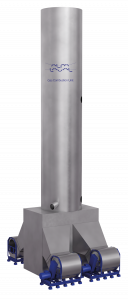
Burning hydrogen
Shell and Alfa Laval in hydrogen boil-off gas project
Shell International Trading and Shipping and Alfa Laval have signed an MOU for the development of a new gas combustion unit (GCU) for use on liquid hydrogen carriers.
February 12, 2023
Under the MOU, Alfa Laval will develop a system to safely combust hydrogen boil-off gas (BOG) from a vessel’s storage tank. In a statement the companies explain that, because the venting of cargo is restricted, a GCU offers a means of controlling tank pressure/temperature when the BOG poses safety risks beyond the tank’s design conditions.
“Renewable hydrogen will likely be a key fuel in tomorrow’s decarbonization mix, but accessibility will determine its impact,” says Carl Henrickson, General Manager of Shipping Technology, Shell. “By enabling safe ocean transport of liquid hydrogen, we can help speed up the global transition to clean energy and Shell’s target to become a net-zero emissions energy business by 2050. Alfa Laval shares our ambition and is our choice of partner.”
“We are proud to support Shell in developing a marine infrastructure for hydrogen,” says David Jung, Business Development Manager, Alfa Laval. “Global hydrogen demand is expected to grow many times larger than it is today, and liquid hydrogen carriers at sea will be a vital link in the world’s decarbonized fuel chain.”
The design of the new GCU system for hydrogen will be based on the existing Alfa Laval GCU for LNG. More than 200 of these units have been installed in just over a decade, and an additional 100 units have been ordered during 2022.
The challenges in hydrogen combustion, however, are significantly greater than those involved with LNG, according to Jung who says: “With its boiling point of -253°C, hydrogen is expected to have a higher boil-off rate than methane, which will make having a GCU or similar means of BOG handling crucial on hydrogen carriers. In addition, hydrogen is light, highly flammable and easy ignitable. Safety will be paramount when transporting it on board, so there are critical safety considerations when designing the GCU system.”
Alfa Laval will design and engineer the new GCU for hydrogen with the aim of receiving an approval in principle (AIP) from an IACS classification society. Once the AIP is achieved, a GCU prototype will be built for testing and type approval.
Twin screw, LNG-splitting VLCC
New design combines reduced light draft and pre-combustion CO2 capture
Italian class society RINA has given Approval in Principle (AIP) for a VLCC design which incorporates an innovative propulsion arrangement that is expected to reduce the ship’s resistance by 5-10%. This is achieved by splitting the thrust of a single large propeller into two smaller ones, thus reducing the required ballast draft for the full propeller immersion, which in turn allows the reduction of the volume of the ballast tanks and, ultimately, of the overall ship dimensions and the required power for propulsion without impacting the cargo carrying capacity.
At the same time, according to RINA, the vessel will meet the IMO GHG reduction targets for 2050 through the use of the ship’s LNG fuel combined with hydrogen produced onboard. The LNG/hydrogen-fuelled vessel general arrangement developed by Shanghai Waigaoqiao Shipbuilding (SWS) is based on the result of a joint project with Marin, the Liberia Administration, Wärtsilä, ABB, Metacon subsidiary Helbio and RINA.
RINA’s Executive Vice President, Giosuè Vezzuto, said: “Following the AIP of an MR tanker, earlier this year, using the same solution to produce hydrogen on board, this vessel features a new approach to the design of VLCCs. It also demonstrates that the gas reforming concept can work equally well on smaller or bigger vessels, as this first AIP for a VLCC proves its application in the largest vessels.”
The propulsion design is based on combining LNG with steam in a Helbio gas reformer to split LNG molecules into hydrogen and CO2. Hydrogen is then directly used to fuel the internal combustion engines and fuel cells. The capture of carbon atom directly from the LNG molecules, serves as a pre-combustion technique, and the cryogenic separation of CO2 from a stream of reformed gases rather than from exhaust emissions results in much smaller installation on bard which eliminates the use of chemicals and the penalty in energy consumption.
“One of the challenges for shipowners in meeting IMO carbon emission targets is knowing what the future holds,” continued Vezzuto. “The industry is considering many options using different technologies and new fuels, aiming to minimize the energy consumption and the resulting CO2 emissions on board. Shipowners need to be confident that onshore bunkering facilities and other supporting infrastructure will be available before investing in new vessels. This LNG/hydrogen fuelled design for VLCCs is modular and scalable and provides a practical solution that can adapt over time to meet increasingly stringent emission reduction targets and ensure their investment is optimized throughout the natural lifespan of the vessel. The design only requires LNG bunkering, which is widely available today.”
Get in touch
Contact one of the World Bunkering team.
Constructive Media
Constructive Media
50 George Street,
Pontypool
NP4 6BY
Tel: 01495 740050
Email: ibia@constructivemedia.co.uk
On behalf of :
IBIA Ltd
107 Cheapside
London
EC2V 6DN
United Kingdom
Tel: +44 (0) 20 3397 3850
Fax: +44 (0) 20 3397 3865
Email: ibia@ibia.net
Website: www.ibia.net
Emails
Publisher & Designer: Constructive Media - ibia@constructivemedia.co.uk
Editor: David Hughes - anderimar.news@googlemail.com
Deputy Editor: Unni Einemo - unni@ibia.net
Project Manager: Alex Corboude - alex@worldbunkering.net
Terms & Conditions | Copyright © 2023 World Bunkering
